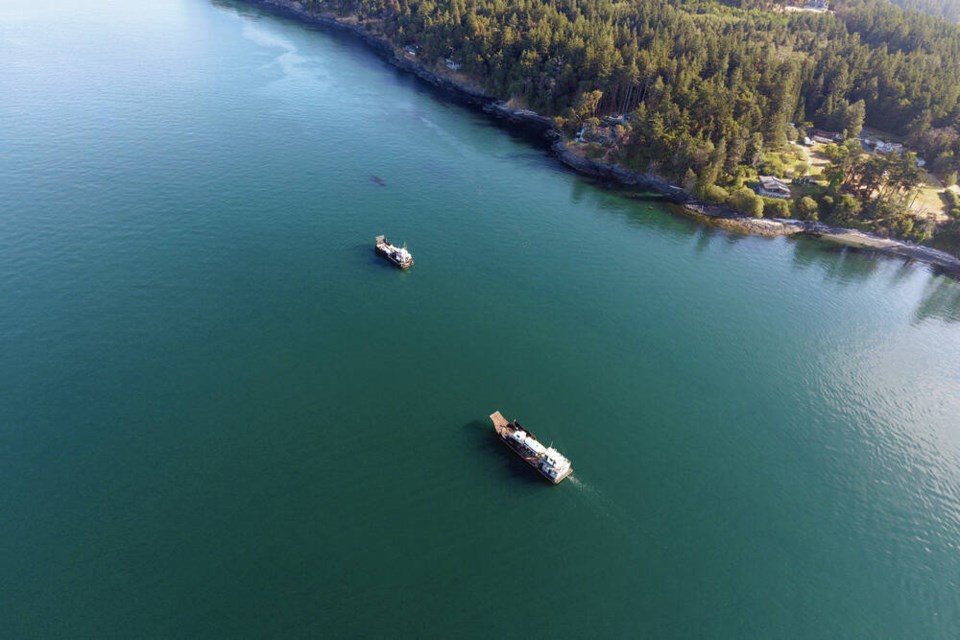A fishing boat that sank with nearly 10,000 litres of fuel on board near the Canada-U.S. marine border, about 25 kilometres east of Victoria, went down in one of the worst possible places for endangered orcas, an ocean pollutants expert says.
Peter Ross, a senior scientist with Raincoast Conservation Foundation, said the vessel sank in an important feeding area for endangered southern resident killer whales. It will be a race against time to clean up the spill, he said.
“The very worrying part of this entire incident is that it happened probably in the worst place of all for southern resident killer whales, right in the middle of critical habitat,” Ross said.
The area is protected under the U.S. Endangered Species Act, he said, because it’s a popular fishing spot for the orcas. Chinook salmon, the whales’ main prey and a species facing its own survival challenges, swim along bluffs on San Juan Island, creating a feeding channel for the orcas.
There are only 74 southern resident killer whales remaining and the federal government says the main threats to the species are contaminants, declining chinook populations and acoustic disturbances.
The U.S. Coast Guard said Monday the whales were last spotted west of Port Angeles, at least 50 kilometres from the spill, but Ross said that’s not more than a day’s journey for the orcas.
The Aleutian Isle sank Saturday off San Juan Island and its five crew members were rescued by a Good Samaritan, the U.S. Coast Guard said.
The vessel is under about 30 metres of water and the fuel on board includes diesel, motor oil and other assorted oils. Officials have not determined what caused the sinking.
On Monday, the coast guard’s Pacific Northwest division said a dive team was looking for the best way to secure vents on the vessel so that the tanks can be defuelled.
Petty Officer Michael Clark told the Associated Press that a sheen had entered Canadian waters and there was concern for the southern resident killer whales last seen near the southern tip of San Juan Island but moving away toward Port Angeles.
By Monday afternoon, they were spotted west of Port Angeles, “well away from the spill,” the coast guard said.
A safety zone has been put in place and all vessels must remain at least 914 metres from any diving vessels, it said.
No whales have been identified in the affected area and personnel are on scene to prevent marine mammals from approaching.
There have been no reports of oiled wildlife and air quality levels remain below harmful thresholds, it said.
Ross warned that the threat is not over. If the whales return, diesel fumes can be extremely toxic to them if inhaled. “That can present significant harm, if at the right concentration, and if there’s no wind to disperse it,” he said.
Diesel can also enter the food chain, beginning on the biofilm on the ocean water’s surface, if it’s ingested by bacteria, phytoplankton and zooplankton.
Of urgent concern, too, is identifying which types of oil and other fuels were on board, he said. Given the threats facing the whales, it’s critical that divers identify the fuels, stop the leaks and possibly work on recovering the vessel, he said. “This is an environmental emergency.”
Conservationists are also watching for effects on salmon. Misty MacDuffee, director of Raincoast’s wild salmon program, said the leak is occurring as sockeye salmon and other migrating species return to the Fraser River.
The fish should be safe from fuel on the water’s surface since they spend most of their time deeper down.
She warned against the use of dispersants to manage the oil because it involves breaking slicks into smaller droplets that can distribute toxins through the water column. “Then it becomes deadly.” Oil can also accumulate on shorelines with damaging effects, she said.
The Canadian Coast Guard said in an email it is ready to assist.
U.S. Coast Guard spokesman Lt.-Cmdr. Brian Dykens said in a statement that government and industry partners are working to develop “an efficient and effective containment and recovery response.”
Washington state-based Orca Network, which monitors the orcas in their traditional summer feeding areas in the Salish Sea, said all three pods of the orcas were in the area a “short distance south of the spill” early Saturday evening.
On Sunday afternoon, the orcas turned around, said Susan Berta of the Orca Network “The resident pods arrived off South San Juan Island and were heading north toward the spill in the evening, but thankfully turned back south.”
She said several organizations listened to hydrophones off North San Jan Island overnight, and it is believed the orcas never entered the area of the spill.
The U.S. Coast Guard is co-ordinating with San Juan Island-based Sound Watch and the National Oceanic and Atmospheric Administration (NOAA) to monitor the location of the orcas and is ready to keep the orcas away.
Because orcas are acoustic animals, NOAA said using loud or annoying sounds is one way to keep whales away from an area contaminated with oil.
Some of the methods that could be used include low-level helicopter flights, or dipping long metal pipes into the water and banging them with hammers.
NOAA also considers underwater firecrackers, often called seal bombs, to deter the orcas. Ironically, the small charges were used in the 1960s and 1970s to help capture killer whales for public display in aquariums. “Now we are using historical knowledge of the whales’ behaviour during those captures to support conservation of the whales,” NOAA’s website said.



